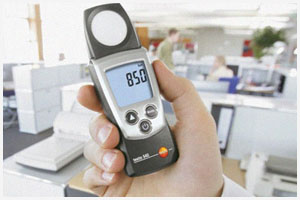
Unfortunately, lighting, which is one of the issues for which the necessary care is not shown in our country, should be designed especially considering the requirements of the work done in the workplaces and the sensitivities of the employees. Because lighting is one of the factors that directly affect the health and safety of employees. In insufficient and inappropriate lighting conditions, eye fatigue may occur primarily or physical fatigue may occur due to the effect of dim light, and these incidents invite occupational accidents.
The workplaces need to be correctly illuminated depending on the sector in which they operate and the working conditions, and the need for illumination may vary depending on the nature of the work. In general, lighting is provided either by natural means or by artificial means. Nowadays, where green buildings increase and energy saving is important, natural lighting is also gaining importance. The preferred approach in office architecture today is to make the most of natural light.
When it comes to lighting, it is meant to be able to use daylight in the most efficient way together with lighting based on electrical energy and lamp assembly. Therefore, lighting should be designed with these in mind in workplaces where day and night work is done. Daylight, which has much more luminous power than artificial lighting, has positive effects on employees and the light intensity in the shade on a sunny day is worth 10 thousand lux. However, the light intensity provided in working environments with artificial lighting is around 500 lux on average.
The luminous intensity that will occur after the necessary measurements are made must be in accordance with the standards and between the highest and lowest limits. These measurements are made to determine the suitability of the light intensities provided in the working environments in the workplace.
The level of illumination is very important, the employee cannot properly work on something that he cannot see clearly and as he should. It is known that lighting has a positive effect on productivity and also affects the attention level of employees.
Lighting affects not only production workplaces, but also all workplaces, institutions and organizations. Hospitals, hotels, supermarkets, etc. It has a very important place in terms of consumer and customer psychology, as well as the employees.
In terms of testing and measurement, there are some responsibilities in the measurement facilities. The facility to be measured should be determined in advance of the lighting intensity measurement points, and these measurement points are determined 80 centimeters above the ground in empty areas, above the production tools in the production facilities and on the work desks in the offices.
In other words, the points to be measured for illumination are the points that need to be illuminated for operation. If measurements are taken during daylight hours, direct sunlight should not be exposed to the measurement points. If the companies request, the measurements are made again at night.
When the test and measurement are completed, a report is generated. In line with this report, if the values obtained by lighting measurements are lower than the required values, the company is warned and requested to take precautions. These measures may include the installation of additional lighting systems, the removal of beam sources or the lighter color of the working environment.
For more information, you can reach our expert team from our contact addresses and phone numbers and you can get answers to all your questions.